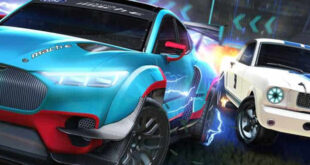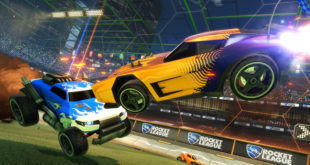Where did the idea for Rocket League (or, rather, its forebear) come from?
We were making a wacky, physics-based car combat game, and one of our level designers decided to drop a giant soccer ball in an arena. We quickly discovered it was super addictive.
What were the biggest lessons learned from Supersonic Rocket-Powered Acrobatic Battle-Cars?
- A bad name can really hurt a game’s appeal.
- The core game was good, even if we didn’t execute as well as we could have. We still had players playing it religiously in 2014/2015 before Rocket League came out.
- We needed to up our game technically to do the concept justice. Low framerate, input lag and laggy peer-to-peer servers greatly hurt the online experience.
What tech did you choose to power the game and why?
Unreal Engine 3. Our studio specialises in Unreal so it was a no brainer for us. We considered trying to jump to UE4 partway through development, but couldn’t be sure it would be shippable in time.
"We didn’t want to create an entirely new set of physics rules for the basketball mode, as players switching between the two would find all their instincts betraying them."
Corey Davis, Psyonix
How much tuning did the physics take?
Too many hours to count. If you include the original game as R&D, we’ve spent three-plus years just perfecting the physics.
We balance by playtesting and getting player feedback. We released a private alpha to our longtime fans and quickly found out we’d become comfortable with a set of physics parameters they were very unhappy with.
Over the course of a few months, we were able to find a healthy balance that Rocket League shipped with.
How did you balance the handling of the cars, making it accessible to players who aren’t overly into driving games?
We didn’t specifically target a type of player. Instead, we sought to make the cars handle effectively and smoothly for the type of game we were making – a game that requires quick directional changes and lateral movement, neither of which is common to racing games.
To be honest, we were afraid our car controls were too sensitive for new players, but that that level of finesse was necessary for the high skill player.
The differences between vehicles are largely aesthetic. Why was this important?
We knew very early on that we wanted players to be able to tailor their cars cosmetically to look however they wanted, and we felt strongly that you shouldn’t have to pick a ‘look’ because of how it performed statistically.
What was the greatest challenge in developing Rocket League?
Our biggest challenge was biting the bullet and extending our timelines (and budget) to add features we felt were necessary for it to be a success. Features like a party system, server-based matchmaking and quick chat were all on the cutting table at some point due to deadlines. But we made the call to push our dates out and do it ‘right’.
How did you enable cross-platform play between the console versions and Windows? What was the most challenging part of this and how did you overcome it?
It mostly involved asking nicely. The technical aspect of cross-network play is fairly straightforward – from our dedicated server’s point of view, a player is a player regardless of what platform they’re playing on.
The bulk of the work is just meeting each platform’s requirements, like blocking unfiltered chat. The most challenging part was keeping the Xbox cross-network announcement a secret.
How did you balance the multiplayer to make it accessible to newer/less-skilled players, to make them feel like they’re contributing to matches?
I wouldn’t say we explicitly sought ways to ‘balance’ for newer or less skilled players. We did specifically slow down the ball impacts from the first game to put more of an emphasis on team play and makes it harder for a single player to dominate a match.
But, to be honest, we also partly just lucked out that ‘newbies’ found it fun long enough to improve.
"The technical aspect of cross-network play is fairly straightforward – from our dedicated server’s point of view, a player is a player regardless of what platform they’re playing on."
Corey Davis, Psyonix
Why add the basketball and ice hockey modes? How did the different physics of these sports challenge the team?
We like to prototype new things, and alternate modes are a good way for us to scratch that itch and also give our players more free content.
Basketball was a particular challenge because we knew we wanted a raised hoop, but our default physics don’t pop the ball up that high. We didn’t want to create an entirely new set of physics rules for the mode, though, as players switching between the two would find all their instincts betraying them.
The sound design is similar to that of a sports game, to the point where you hear sneakers skidding on the court while driving in the basketball mode. Why was this important?
We just looked for any touches we could add to make it feel more like you were a player on the field. Most sports games emphasise a more managerial aspect – you control the entire team at once. But we felt one of our strengths was that sensation of being IN the match yourself.
As for the basketball mode, the sneaker squeaks were a particularly brilliant idea by our sound designer, Mike Ault, who also wrote a lot of the songs on our soundtrack with his band, Hollywood Principle.

 MCV/DEVELOP News, events, research and jobs from the games industry
MCV/DEVELOP News, events, research and jobs from the games industry



